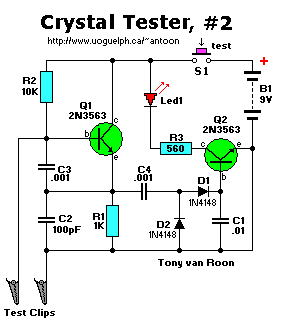
Parts List:
R1 = 1K C1 = 0.01uF (10nF)
R2 = 10K C2 = 0.1uF (100nF)
R3 = 560 Ohm C3,C4 = 0.001uF (1nF)
Q1,Q2 = 2N3563 Led1 = Red Led
D1,D2 = 1N4148 S1 = Momentary Push-button, SPST
Miscellaneous: crocodile clips (or others), 9V battery clip, wire, solder, etc.
Notes:
Transistor Q1, a 2N3563, and its associated components form an oscillator circuit that will oscillate if, and only if,
a good crystal is connected to the test clips. The output from the oscillator is then rectified by the two 1N4148 signal
diodes (1N914 are fine too) and filtered by C1, a 0.01uF ceramic capacitor.
The positive voltage developed across the capacitor is applied to the base of Q2, another 2N3563, causing it to conduct.
When that happens, current flows through Led1, causing it to glow. Since only a good crystal will oscillate, a
glowing LED indicates that the crystal is indeed OK.
None of the components are very critical (with exception of Q1/Q2). Use whatever you have in your junk-box.
The NTE108 is a direct replacement for the 2N3563.
The circuit is powered by a standard 9-volt battery and the SPST push button power-switch is included to prolong
battery life.
The circuit should oscillate fine with a good xtal with a frequency between 2 and 8MHz. It is possible, depending on
your choice of components (or age) that the led will glow dimly without a crystal present. That's okay considering the
simplicity of the circuit. Ignore it.
Back to Circuits Page
Copyright © Tony van Roon

